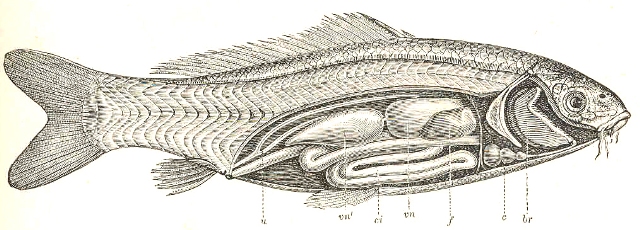 While the influence of Carl Friedrich Phillip von Martius on the work of Louis Agassiz is not often spoken of, it is undeniable that the circumstances between them truly enlightened Louis Agassiz. After the historic expedition of von Martius and von Spix to Brazil, Agassiz was brought in to work out the history of a set of freshwater fish that von Spix was unable to analyze before his death. It can be said that this was Louis Agassiz’s introduction to ichthyology which connected him to Georges Cuvier, a person of great note in his life. Agassiz’s work with the fossilized fish impressed Cuvier to such a degree that he was prompted to hand over all of his notes to the promising young Agassiz.
While the influence of Carl Friedrich Phillip von Martius on the work of Louis Agassiz is not often spoken of, it is undeniable that the circumstances between them truly enlightened Louis Agassiz. After the historic expedition of von Martius and von Spix to Brazil, Agassiz was brought in to work out the history of a set of freshwater fish that von Spix was unable to analyze before his death. It can be said that this was Louis Agassiz’s introduction to ichthyology which connected him to Georges Cuvier, a person of great note in his life. Agassiz’s work with the fossilized fish impressed Cuvier to such a degree that he was prompted to hand over all of his notes to the promising young Agassiz.
Agassiz was appointed a professor of natural history at the University of Neuchatel in 1832. The fossilized fish found in the slates of Glarus and limestones of Monte Bolca were essentially untouched at that time and commanded his attention. These outcrops led the foundation of his fame as he published Recherches sur les poissons fossils (Research on the fossils of fish) in five volumes over a time interval from 1833 to 1843.


Belabored by the sheer number of fossils found in the outcrops, Agassiz found it necessary to designate a new ichthyological classification system. He decided to classify the fish based on the nature of the scales and dermal appendages. The four groups he created were as follows: Ganoids, Placoids, Cycloids, and Ctenoids. Although Agassiz attempted to base this classification system on science, the system was soon replaced due to the fact the fish are a far more diverse assortment than can be explained through those four groups. Instead, these four groups have been redefined to types of fish scales.
- Placoid – This type of scale occurs in the Selachimorpha supergroup (sharks and rays) and consists of variously shaped particles of lime that prick through the skin. These protrusions in the skin are the same material as the teeth in the mouth without any change in structure.
- Ganoid – These types of scales are those that formed the armor of extinct ganoid fishes. The descendants of this type of fish can be seen in the modern gar pikes and billfish. In fossils, these scales appear rounded and overlap with each other. In modern fish, these scales are rhombic and are connected edge to edge covering the whole body of the fish. These scales are moderately flexible to allow for ease of motion. While the outer covering of scale is enameled, the rest of the scale is made of a bonelike substance.
- Ctenoids and Cycloids – Theses scales are those of ordinary fishes and are very similar to each other except for the fact that the hinder end of ctenoid scales are split into a comb-like fringe. They have either a rounded or polygonal form and are also thin and translucent. The types of scales also grow with age, which can be seen by the growth on the edges of the scales.
As Agassiz continued his work with ichthyology, he soon found himself in somewhat of a financial crisis. This was alleviated by the British Association, the Earl of Ellesmere, and Lord Francis Egerton who all in invested a significant amount of coin in Agassiz’s future research. The many drawings Agassiz made for his work, which amounted to the astronomical number of 1290, were purchased by the Earl and later presented in front of the Geological Society of London, which in turn led to Agassiz being awarded the Wollaston Medal for his work in ichthyology in 1836.
Interestingly enough, Agassiz was also the only person to honor the work of Mary Anning by naming a species after her during her lifetime. In a time where many people looked down upon her for her lack of formal education and almost ridiculously large finds, it is good to see that Agassiz welcomed her achievements with great respect.